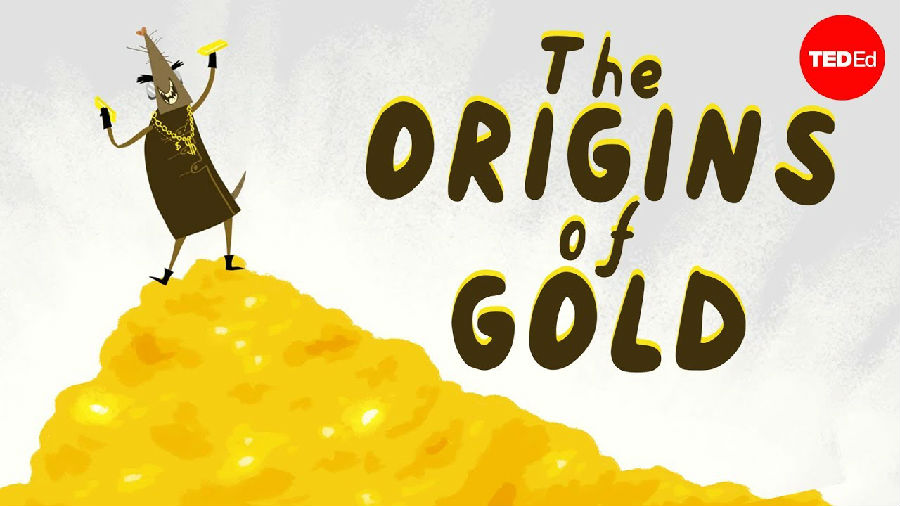(单词翻译:单击)
In medieval times, alchemists tried to achieve the seemingly impossible.
在中世纪,炼金术士们总是梦想着完成一些不可能的事情。
They wanted to transform lowly lead into gleaming gold.
他们想把锈迹斑斑的铁块变成亮闪闪的金子。
History portrays these people as aged eccentrics, but if only they'd known that their dreams were actually achievable.
历史学家们觉得这些人是怪人,但是他们不知道这些梦想事实上是现实的。
Indeed, today we can manufacture gold on Earth thanks to modern inventions that those medieval alchemists missed by a few centuries.
如今,我们可以大量生产金块,多亏了那些在炼金术士时代尚未出现的现代发明。
But to understand how this precious metal became embedded in our planet to start with,
但是想要了解这稀有金属是如何点缀我们的星球的,
we have to gaze upwards at the stars. Gold is extraterrestrial.
我们得先仰望星空。探索宇宙的奥秘。金存在于外星球上。
Instead of arising from the planet's rocky crust,
它并不是直接形成于地壳上,
it was actually cooked up in space and is present on Earth because of cataclysmic stellar explosions called supernovae.
而是来自宇宙,由于超新星爆炸而来到地球。
Stars are mostly made up of hydrogen, the simplest and lightest element.
恒星由宇宙中最简单、最轻的元素氢构成。
The enormous gravitational pressure of so much material compresses and triggers nuclear fusion in the star's core.
由于巨大的引力,氢被压缩并激发横行的核聚变。
This process releases energy from the hydrogen, making the star shine.
这一过程会释放能量,令其发光。
Over many millions of years, fusion transforms hydrogen into heavier elements:
几百万年来,核聚变将氢元素转化成一些更沉的元素:
helium, carbon, and oxygen, burning subsequent elements faster and faster to reach iron and nickel.
如氦、碳、氧,并支持它们快速燃烧,最终变为铁或镍。
However, at that point nuclear fusion no longer releases enough energy, and the pressure from the core peters out.
然而,当核聚变不再释放能量时,核中的气压也会逐渐降低。
The outer layers collapse into the center,
外层因此破裂崩塌,向心坠入,
and bouncing back from this sudden injection of energy, the star explodes forming a supernova.
恒星从被突然注入的能量恢复之后,爆炸形成超新星。
The extreme pressure of a collapsing star is so high,
爆裂的恒星的气压非常大,
that subatomic protons and electrons are forced together in the core, forming neutrons.
使得质子和电子被贴在一起,在核中形成中子。
Neutrons have no repelling electric charge so they're easily captured by the iron group elements.
中子不带电荷,所以它们很容易被铁元素吸引。
Multiple neutron captures enable the formation of heavier elements
很多中子促进了更沉的元素的形成,
that a star under normal circumstances can't form, from silver to gold, past lead and on to uranium.
使得在一般情况下的恒星不能从银变为金,铅和铀。

In extreme contrast to the million year transformation of hydrogen to helium,
由氢到氦的形成大概要几百万年,
the creation of the heaviest elements in a supernova takes place in only seconds.
然而超新星中最沉的元素的形成只需要仅仅几秒钟。
But what becomes of the gold after the explosion?
那么爆炸后的结果是什么呢?
The expanding supernova shockwave propels its elemental debris through the interstellar medium,
不断扩展的超新星冲击波用它的星际间介质推进它的残骸,
triggering a swirling dance of gas and dust that condenses into new stars and planets.
使其带动周围的气体和尘埃旋转,最后又凝缩成心的恒星和行星。
Earth's gold was likely delivered this way before being kneaded into veins by geothermal activity.
在被开发成金矿前,地球上的金子很可能就是这么形成的。
Billions of years later, we now extract this precious product by mining it,
几十亿年后,我们开采这稀有的物质,
an expensive process that's compounded by gold's rarity.
因为它的稀有,所以开采过程变得很昂贵。
In fact, all of the gold that we've mined in history could be piled into just three Olympic-size swimming pools,
事实上,人类史上开采过的所有金矿仅仅能填满三个奥林匹克级别的游泳馆而已,
although this represents a lot of mass because gold is about 20 times denser than water.
尽管它们质量很高,因为金比水重20倍。
So, can we produce more of this coveted commodity? Actually, yes.
所以,我们可以生产更多的这令人垂涎的金子吗?答案是可以的。
Using particle accelerators, we can mimic the complex nuclear reactions that create gold in stars.
我们可以使用粒子加速器来模仿复杂的核反应,进而产生宇宙中的金。
But these machines can only construct gold atom by atom.
但这些机器只能通过原子来制造金。
So it would take almost the age of the universe to produce one gram at a cost vastly exceeding the current value of gold.
制造一克金所需的时间像宇宙形成一样漫长,同时花费也远超制成的金的价值。
So that's not a very good solution.
所以这并不是一个明智的选择。
But if we were to reach a hypothetical point where we'd mined all of the Earth's buried gold,
不过如果假设我们能够开采世界上所有的金,
there are other places we could look.
那么就有其他的地方供我们选择。
The ocean holds an estimated 20 million tons of dissolved gold
海洋里大概包含两千万吨未溶解的金,
but at extremely miniscule concentrations making its recovery too costly at present.
不过因为它们集中在很小的区域,开采所需花费巨大。
Perhaps one day, we'll see gold rushes to tap the mineral wealth of the other planets of our solar system. And who knows?
也许有一天,我们可以看到淘金热在太阳系的其它行星上流行起来。谁知道呢?
Maybe some future supernova will occur close enough to shower us with its treasure
也许在将来超新星会距离我们越来越近,洒落大批黄金,
and hopefully not eradicate all life on Earth in the process.
同时不要毁灭地球上的其它物质。


